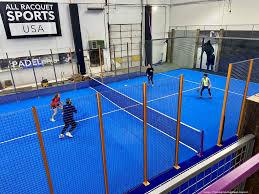

The Cost of Building a Padel Court in China
Padel, a racquet sport that combines elements of tennis and squash, has gained immense popularity worldwide over recent years. Its popularity is now catching on in China, prompting enthusiasts and investors to consider building their own padel courts. However, before diving into this venture, it's important to understand the various factors that contribute to the cost of constructing a padel court in China.
1. Location and Land Costs
The first aspect to consider is the location. Real estate prices vary significantly between urban and rural areas. In major cities like Beijing, Shanghai, or Guangzhou, land prices can be skyrocketing, which increases the overall cost of building a padel court. Conversely, in less populated regions, land costs are usually much lower. It's crucial to evaluate local market conditions and select a site that balances accessibility and affordability to minimize costs.
2. Court Construction Costs
The construction of the court itself is one of the most substantial expenses. A standard padel court measures 20 meters long and 10 meters wide, enclosed by walls and made from durable materials such as glass and metal. The cost can vary based on the quality of the materials chosen. For instance, using high-quality glass for the walls will significantly increase the price. Additionally, the choice of flooring—whether synthetic turf, concrete, or others—will also add to the costs.
On average, the construction of a single padel court in China can range from around 200,000 to 500,000 RMB (approximately $30,000 to $75,000), depending on the specifications and materials used. It’s also essential to factor in costs related to site preparation, including earthworks and possibly landscaping, which can add an additional 10-20% to the overall cost.
Navigating the legal landscape is another aspect that can influence costs. In China, local regulations vary significantly regarding land use and construction. Obtaining the necessary permits can take time and may involve fees. It’s crucial to research local regulations and work with legal experts or consultants who can streamline the process and help avoid unexpected expenses. This aspect can add anywhere from 5% to 15% to the overall budget.

4. Additional Amenities and Facilities
For those looking to enhance the attractiveness of the padel court, additional amenities and facilities could be included in the project. Options like locker rooms, showers, a small café, seating areas for spectators, and lighting for nighttime play can significantly impact the total cost. These enhancements can provide a more professional environment and improve the user experience, but they will also inflate the budget further, potentially doubling the initial investment.
5. Maintenance Costs
After the court is built, ongoing maintenance is another factor to consider for long-term sustainability. This includes costs related to surface repairs, cleaning, replacing lighting, and ensuring the court's overall upkeep. An annual maintenance budget of around 10% of the initial construction cost is a typical estimate for such facilities.
6. Market Potential and ROI
Finally, it’s essential to consider the return on investment (ROI). As the popularity of padel continues to grow, a well-constructed padel court in a strategic location could generate significant revenue through memberships, tournaments, and events. Therefore, while the initial costs might be high, the potential for profit could justify the investment.
Conclusion
Building a padel court in China requires careful financial planning and consideration of various factors that affect cost. From land and construction expenses to regulatory hurdles and potential revenue streams, understanding these elements will help prospective builders create a successful facility that caters to the growing interest in padel. If managed wisely, investing in a padel court can prove to be a rewarding venture in a rapidly expanding sport market.
High-Performance Industrial Flooring Solutions China Paddle Tennis Court for Sale
High-Performance Industrial Flooring Solutions Durable & Cost-Effective
Homogeneous Transparent Floor – Durable & Stylish Rubber Floor Solutions
Premium Homogeneous Transparent Floor for Durable & Stylish Spaces Rubber Floor Solutions
Premium Sports Floor Solutions Durable PVC Sports Floor & Rubber Floor for Gyms
Durable Rubber Composite Floor Premium Rubber Floor & Mats Solutions